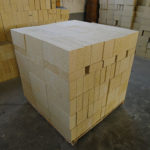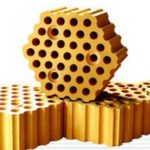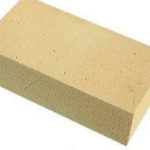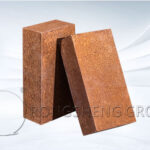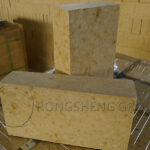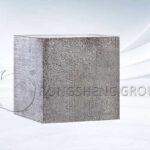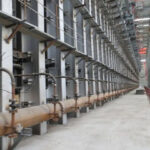Oxygen combustion glass kilns have become a development trend due to their energy-saving and environmental protection characteristics. However, along with this combustion technology, the high concentration of NaOH in the kiln atmosphere caused accelerated erosion of the refractory materials of the furnace and superstructure. Therefore, the binding phase of silica bricks was changed to remove the weak point of the calcium silicon oxide phase, and Calcium-Free Silica Bricks for Oxy-Combustion Glass Kiln were developed.
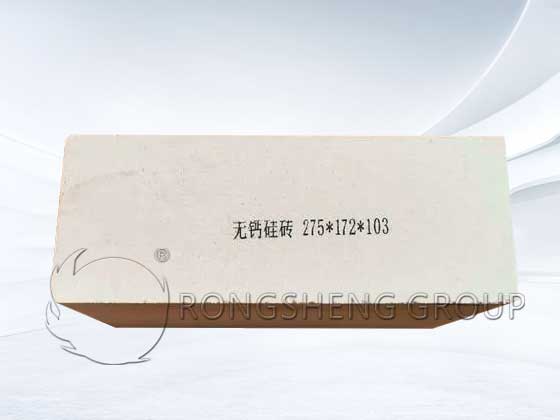
Calcium-free Silica Bricks for Glass Kilns
New calcium-free silica bricks specially designed for glass kilns, using a calcium-free bonding firing process. The products have excellent chemical stability, physical and chemical properties are better than similar imported products, and can replace equivalent imported products. This product has been used by many domestic glass manufacturers and has been well-received by customers. The special calcium-free silica bricks for glass kilns can be produced and processed into various brick types according to customer drawings, including complex brick types.
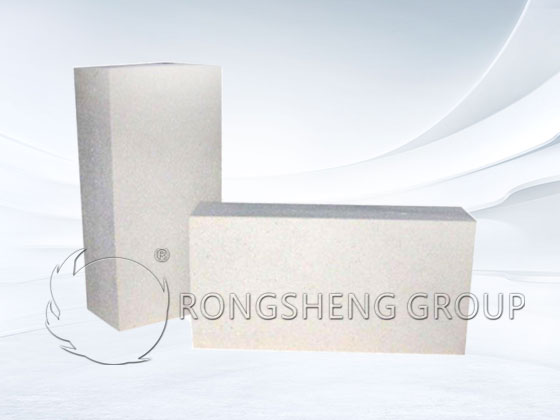
Product Features of Calcium-free Silica Bricks for Glass Kilns
- Adopting a calcium-free bonding production process, the product has excellent chemical stability. The alkali corrosion resistance is significantly improved compared with the traditional high-quality silica bricks used for glass kiln ballast roofs. It can be used in various parts of the high-alkali glass tank kiln, such as the large furnace, the tongue furnace, and the small furnace.
- The product has a high load softening temperature of 1690°C and can be used in high-temperature glass kilns.
- The thermal expansion rate of the product is lower than the high-quality silica bricks used in general glass kilns, and it will not expand or crack after long-term use.
- Microstructural characteristics of calcium-free silica bricks for glass kilns:
The cristobalite crystal phase improves the high-temperature performance of the product, and the soft-loading temperature is higher. The micro-expansion property makes the product structurally stable during use, and the presence of the amorphous glass phase improves the rapid cooling and heating properties of the product.
- Thermal expansion properties of calcium-free silica bricks for glass kilns:
The thermal expansion rate of calcium-free silica bricks for glass kilns is between that of ordinary silica bricks and fused quartz thermal repair bricks, and they will not shrink after long-term use at high temperatures.
Application of Calcium-free Silica Bricks
Application of calcium-free silica bricks in small furnaces and tongues of glass kilns. For example, bottle glass kilns, small furnaces, tongue kilns, high alkali and high load tank kilns, soda and water glass kilns. Specially used in high-temperature, high-load, and high-alkali glass tank kilns of oxy-combustion furnaces. Glass kiln furnaces for colorless and colored bottles and jars, superstructure, and float kiln furnaces.
Performance Effects of Calcium-free Silica Bricks in Oxygen-fired Glass Furnaces
The production process characteristics of calcium-free silica bricks make the silica brick components not contain calcium oxide, which greatly improves the resistance to alkali erosion. The results of the alkali resistance test can be seen as follows:
① Calcium-free silica brick reacts with sodium carbonate at high temperatures to form a glass phase. After cooling, the glass still remains in the pores of the sample, with no obvious penetration and diffusion, and no obvious erosion. The surface of the brick body is complete, with only a small amount of cristobalite crystallization.
②Severe erosion has occurred in the pores of ordinary silica bricks, a large amount of matrix has been corroded, and large silica particles have been exposed. Alkaline substances diffuse and penetrate through the pores, forming an obvious metamorphic layer. Due to the presence of low-melting substances such as calcium oxide in ordinary silica bricks, they react with soda ash NaCO3 at high temperatures, and the resulting liquid phase penetrates the interior of the gold bricks to form a metamorphic layer.
Calcium-free silica bricks exhibit a quartz glass phase and cristobalite phase under the microscope. The role of the quartz glass phase makes calcium-free silica bricks have high-temperature resistance and corrosion resistance. The cristobalite phase makes up for the crystallization problem of the quartz glass phase, making the calcium-free silica bricks have high load, soft, and low creep properties so that they calcium-free silica bricks can be used stably for a long time.
Silica Bricks for the Glass Industry
Silica brick materials are widely used in the glass industry and have very good corrosion resistance at temperatures >1470°C. The volume density is small, about 1.8g/cm, which is easy to install and the price is relatively low. The above characteristics make silica bricks an indispensable material for glass kiln furnaces and superstructures.
Modern standard high-quality silica bricks contain 95 to 97% silica and about 2.5% CaO. The SiO2 matrix exists in the form of rhombohedral quartz and cristobalite, accounting for 94% of the silica brick. In addition, the remaining SiO2 combines with CaO to form a calcium silicon oxide (CaO·Sio2) combined phase, with a composition of about 5%. Silica bricks are corroded by alkali vapor from the glass melting pool during the use of the kiln furnace and superstructure, such as alkalis produced during the melting process of soda-lime glass.
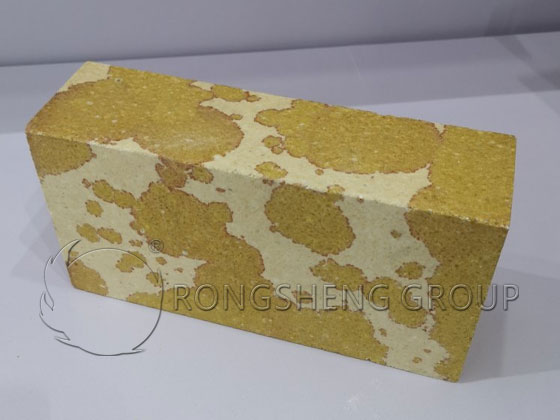
The phase diagram of soda calcium silicon Na2O-CaO-SiO2 can explain the chemical reaction process of silica bricks with alkaline substances in the kiln atmosphere. Ignoring the impurities of bricks, the composition of standard bricks can cause calcium silicon oxide to melt and form SiO2, CaO, and Na2O flows in high-temperature environments. At a temperature of 1350°C, different sodium content balance components move toward the Na2O direction of the ternary system respectively. When the silica brick is completely melted at 1400°C, 1500°C, and 1600°C, it forms a +Na2O component. Due to the dissolution of calcium silicon oxide, the CaO component content of the hot end surface is lower than 0.7%. A part of the melt rich in SiO2, CaO, and Na2O flows into the glass molten pool. The other part of the melt will penetrate toward the cold end of the brick, causing the CaO content at the center of the brick to reach 3.5%, which is higher than 2.5% at the cold end. As we all know, the CaO content of standard silica bricks is 2.5%. At this time, you can see the flow of material migrating from the hot side of the brick to the cold side. The dominant mineral phase in all analyzed samples is cristobalite, which indicates that the temperature of the silica bricks exceeded 1470°C during use.
As described above, the mechanism of erosion of standard silica bricks in all-oxygen glass kilns is mainly due to the dissolution of calcium silicon oxide in the silica brick binding phase caused by alkali vapor, and the further erosion and melting of SiO2 by the melt. In response to this mechanism, the binding phase of the silica brick was changed to remove the weak point of the calcium silicon oxide phase, and the calcium-free silica brick was developed.
To purchase high-quality silica bricks for glass kilns, zero-expansion silica bricks, calcium-free silica bricks, etc., please contact us. We are an RS refractory brick manufacturer.


